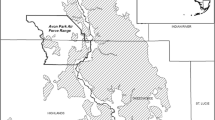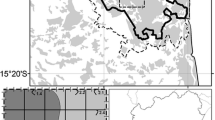Abstract
We report on community structural, ecophysiological, phenological, and morphological measurements made on woody plant species in the high elevation pre-altiplano zone on the western slopes of the Andean Cordillera of northern Chile. Notwithstanding extreme conditions of low rainfall, high atmospheric vapour demand and diurnal temperature fluctuation, a diversity of habitats (associated with drainage and slope aspect), appreciable local plant species richness (28 woody perennial plant species in a small area), and an array of adaptive morphological ecophysiological and phenological traits are present among woody species in these shrublands. Family diversity was low with four families accounted for 82% of the species. A range of gas exchange and watering use efficiency strategies was present ranging from highly efficient CAM species with a carbon isotope discrimination (Δ) of 3.7–7.5‰ through C3 species with varying stomatal and gas exchange characteristics with a Δ of 14.4 to 19.8‰. Drought-deciduous small-leaved amphistomatic species from arid slopes generally had high stomatal conductance and high carbon assimilation rates during the rainy season. These drought deciduous species were largely leafless and, with one exception had low water potentials, during the dry season. Wash and less xeric site species commonly had broader evergreen to semi-evergreen leaves, higher dry season water potentials, and relatively consistent and moderate rates of gas exchange throughout the year. For all species, intrinsic water use efficiency (as estimated from the inverse of c i :c a ratio) correlated positively with mean leaf width (broader leaves had a lower higher intrinsic WUE) and dry season water potential. The charismatic high altitude tree, Polylepis rugulosa (Roaceae), had a population structure that suggests highly episodic establishment of seedlings, likely in sequences of wet years. Little of the area of these significant shrublands is currently protected. It would be desirable to add areas of pre-altiplano shrublands to adjacent national parks to ensure the persistence of these important communities.
Similar content being viewed by others
References
Arroyo M.T.K., Squeo F.A., Armesto J.J. and Villagrán C. 1988.Effects of aridity on plant diversity in the northern Chilean Andes: results of a natural experiment. Annals of the Missouri Botanical Gardens 75: 55–78.
Arroyo M.T.K., Villagràn C., Marticorena C. and Armesto J. 1982. Flora y relaciones biogeogràficas en una transecta altitudinal en los Andes del Norte de Chile (18-19° S). In: Velos M. and Bustos E. (eds), El ambiente natural y las poblaciones humanas de los Andes del Norte Grande de Chile (Arica, lat. 18°28′ S).UNESCO, Santiago, pp. 71–92.
Cabrera A.L. 1957. La vegetación de la Republica Argentina. VI.La vegetación de la Puna Argentina. Revista de Investigaciones Agrícolas 11: 317–412.
CONAF 1986. Plan de manejo del Parque Nacional Lauca. Documento de Trabajo No. 82. Corporación Nacional Forestal, Santiago.
Ehleringer J.R. 1993. Carbon and water relations of desert plants: an isotopic perspective. In: Ehleringer J.H., Hall A.E. and Farquhar G.D. (eds), Stable Isotopes and Plant Carbon-water Relations.Academic Press, San Diego, pp. 155–172.
Ehleringer J.R., Comstock J.P. and Cooper T.A. 1987. Leaf-twig differences in carbon isotope in twig-photosynthesizing desert shrubs. Oecologia 71: 318–320.
Ehleringer J.R. and Cooper T.A. 1988. Correlations between carbon isotope ratio and microhabitat in desert plants. Oecologia 88: 430–434.
Ehleringer J.R., Rundel P.W., Palma B. and Mooney H.A. 1998.Carbon isotope ratios of Atacama Desert plants reflect hyperaridity of the region. Revista Chilena de Historia Natural 71: 79–86.
Farquhar G.D., O'Leary M.H. and Berry J.A. 1982. On the relationship between carbon isotope discrimination and the intercellular carbon dioxide concentration of leaves. Australian Journal of Plant Physiology 9: 121–137.
Gajardo R. 1994. La vegetación natural de Chile: clasificación y distribución geográphica. Editorial Universitaria, Santiago, 165 p.
Gajardo Letelier M. 1997. Caracterizaci ón florística de differentes ambientes de la Región Tarapaca (1a Región, Chile). Universidad de Chile, Facultad de Ciencias Agrarias y Forestales, Santiago.Gibson A.C. 1996. Structure-Function Relations of Warm Desert Plants. Springer-Verlag, Berlin.
Gibson A.C. and Rundel P.W. 2001. Browningia candelaris in the Andean pre-puna of northern Chile. Cactus and Succulent Journal 73: 27–33.
Hensen I. 1995. Die Vegetation von Polylepis-Wäldern der Ostkorrdillere Boliviens. Phytocoenologia 25: 235–277.
Hernández S. 1980. Zonificación con fines de manejo de las formaciones vegetales presentes en el Parque Nacional Lauca (1a Región). Universidad de Chile.
Kessler M. 1995a. The genus Polylepis (Rosaceae) in Bolivia. Candollea 50: 131–171.
Kessler M. 1995b. Revalidacíon de Polylepis rugulosa Bitter (Rosaceae).Gayana Botánica 52: 49–51.
Kött A., Gaupp R. and Wörner G. 1995. Miocene to Recent historyof the western Altiplano in northern Chile revealed by lacus-trine sediments of the Lauca Basin (18°15′-18°40′ S/69°05′ W). Geologische Rundschau 84: 770-780.
Messerli B., Grosjean M. and Vuille M. 1997. Water availability, protected areas, and natural resources in the Andean desert Altiplano.Mountain Research and Development 17: 229–238.
Midgley G.F. and Moll E.J. 1993. Gas exchange in arid-adapted shrubs: When is efficient water use a disadvantage? South African Journal of Botany 59: 491–495.
O'Leary M.H. 1988. Carbon isotopes in photosynthesis. Bio-Science 38: 328–336.
Pearson O.P. 1951. Mammals in the highlands of southern Peru.Bulletin of the Museum of Comparative Zoology 106: 117– 174.
Quintanilla V.G. 1988. Fitogeografia y cartografia de la vegetación de Chile arido. Área Geociencias VI, No. 82, 1–27. Contibuciones Científicas y Tecnológicas.
Rundel P.W., Dillon M.O., Palma B., Mooney H.A., Gulmon S.L.and Ehleringer J.R. 1991. The phytogeography and ecology of the coastal Atacama and Peruvian deserts. Aliso 11: 1–50.
Rundel P.W., Esler K.J. and Cowling R.M. 1999. Ecological and phylogenetic patterns of carbon isotope discrimination in the winter-rainfall flora of the Richtersveld, South Africa. Plant Ecology 142: 133–148.
Rundel P.W. and Palma B. 2000. Preserving the unique puna ecosystems of the Andean Altiplano: Lauca National Park, Chile.Mountain Research and Development 20: 262–271.
Rundel P.W., Palma B., Dillon M.O., Sharifi M.R., Nilsen E.T. and Boonpragob K. 1997. EsTillandsia landbeckii in the coastal Atacama Desert of northern Chile. Revista Chilena de Historia Natural 70: 341–348.
Ruthsatz B. 1977. Pflanzengesellschafen und ihre Lebensbedingungen in den andinen Halbwüsten Nordwest-Argentiniens. Dissertations Botanicas 39: 1–168.
Simpson B.B. 1975. Pleistocene changes in the flora of the high tropical Andes. Paleobiology 1: 273–294.
Simpson B. 1979. A review of the genus Polylepis (Rosaceae: Sanguisorbeae).Smithsonian Contributions to Botany 43: 1–62.
Villagràn C., Arroyo M.T.K. and Armesto J. 1982. Vegetaciòn de una transecta altitudinal de Norte de Chile (18-19° S). In: Velos M. and Bustos E. (eds), El Ambiente Natural y las Poblaciones Humanas de los Andes del Norte Grande de Chile (Arica, Lat. 18°28′ S). UNESCO, Santiago, pp. 13-70.
Wand S.J.E., Esler K.J., Rundel P.W. and Sherwin H.W. 1999. A preliminary study of the responsiveness to seasonal atmospheric and rainfall patterns of wash woodland species in the arid Richtersveld. Plant Ecology 142: 149–160.
Weberbauer A. 1936. Phytogeography of the Peruvian Andes. Field Museum of Natural History (Chicago). Botanical Series 13: 13–81.
Winter K. and Troughton J.H. 1978. Photosynthetic pathways in plants of coastal and inland habitats of Israel and the Sinai.Flora 167: 1–34.
Ziegler H., Batanouny K.H., Sankhla N., Vyas O.P. and Stichler W. 1981. The photosynthetic pathway types of some desert plants from India, Saudi Arabia, Egypt and Iraq. Oecologia 48: 93– 99.
Author information
Authors and Affiliations
Corresponding author
Rights and permissions
About this article
Cite this article
Rundel, P., Gibson, A., Midgley, G. et al. Ecological and ecophysiological patterns in a pre-altiplano shrubland of the Andean Cordillera in northern Chile. Plant Ecology 169, 179–193 (2002). https://doi.org/10.1023/A:1026075721045
Issue Date:
DOI: https://doi.org/10.1023/A:1026075721045




